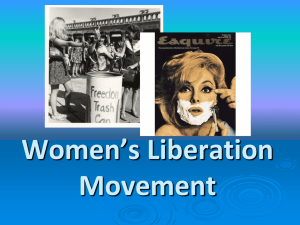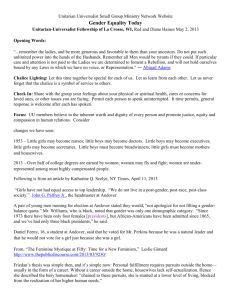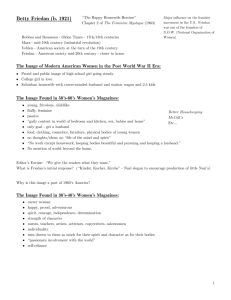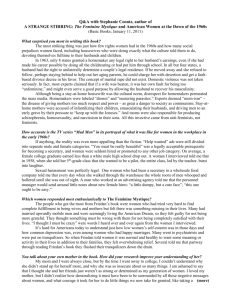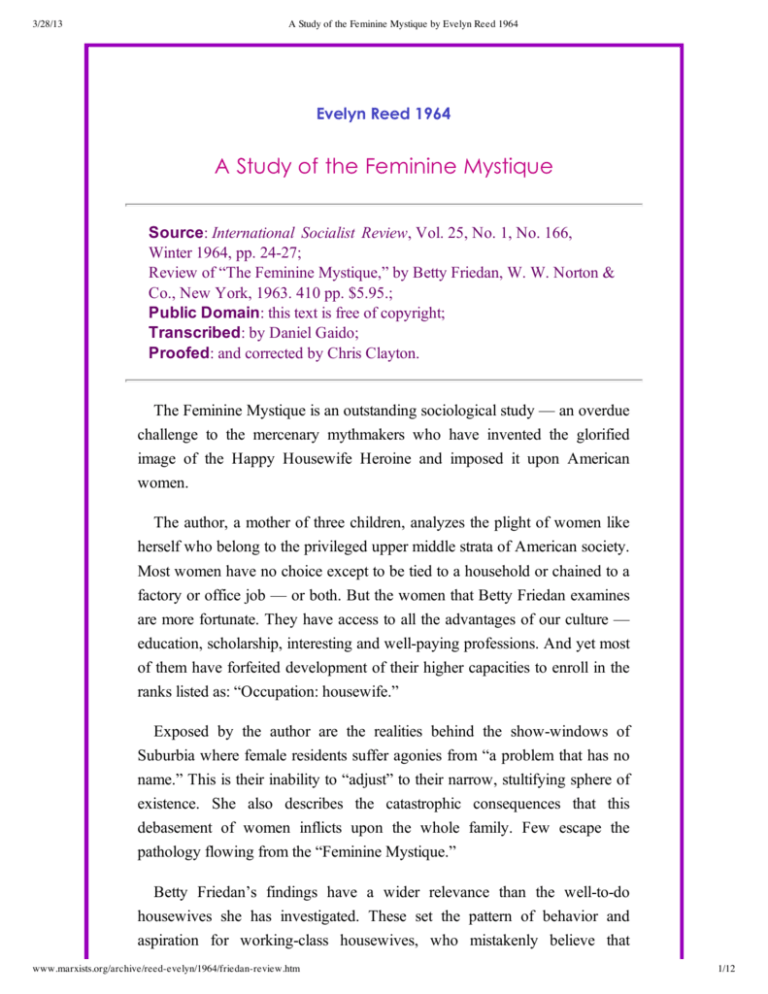
3/28/13
A Study of the Feminine Mystique by Evelyn Reed 1964
Evelyn Reed 1964
A Study of the Feminine Mystique
Source: International Socialist Review, Vol. 25, No. 1, No. 166,
Winter 1964, pp. 24-­27;;
Review of “The Feminine Mystique,” by Betty Friedan, W. W. Norton &
Co., New York, 1963. 410 pp. $5.95.;;
Public Domain: this text is free of copyright;;
Transcribed: by Daniel Gaido;;
Proofed: and corrected by Chris Clayton.
The Feminine Mystique is an outstanding sociological study — an overdue
challenge to the mercenary mythmakers who have invented the glorified
image of the Happy Housewife Heroine and imposed it upon American
women.
The author, a mother of three children, analyzes the plight of women like
herself who belong to the privileged upper middle strata of American society.
Most women have no choice except to be tied to a household or chained to a
factory or office job — or both. But the women that Betty Friedan examines
are more fortunate. They have access to all the advantages of our culture —
education, scholarship, interesting and well-­paying professions. And yet most
of them have forfeited development of their higher capacities to enroll in the
ranks listed as: “Occupation: housewife.”
Exposed by the author are the realities behind the show-­windows of
Suburbia where female residents suffer agonies from “a problem that has no
name.” This is their inability to “adjust” to their narrow, stultifying sphere of
existence. She also describes the catastrophic consequences that this
debasement of women inflicts upon the whole family. Few escape the
pathology flowing from the “Feminine Mystique.”
Betty Friedan’s findings have a wider relevance than the well-­to-­do
housewives she has investigated. These set the pattern of behavior and
aspiration for working-­class housewives, who mistakenly believe that
www.marxists.org/archive/reed-evelyn/1964/friedan-review.htm
1/12
3/28/13
A Study of the Feminine Mystique by Evelyn Reed 1964
because middle-­class women have all the advantages, they also have all the
answers. In this way distorted ideas and values seep down to infect masses of
women, including some working women who wonder whether they might
not lead a better life as a full-­time housewife. This book should help settle
their doubts.
Springing Old Trap
The Feminine Mystique is a modernized version of the old formula for
domestic enslavement more bluntly expressed as “Woman’s place is in the
home.” The new element is the poisoned bait of the Mystique by which
women today are voluntarily lured back into the trap that their grandmothers
fought to escape from.
Betty Friedan reminds us that in the nineteenth century and in the first
decades of the twentieth, progressive middle-­class women led an inspiring
“feminist” struggle for women’s rights. Out of this rebellion they won the
right to higher education, participation in production, professional careers,
independent ownership of property and the vote. These reforms were an
immense improvement over their previous chatteldom, and could have been a
springboard to further advances to full human stature and dignity.
Instead, the Second World War and its aftermath brought about a sweeping
setback, characterized by the author as a “counter-­revolution” against women.
The call for this retreat was sounded by Farnham & Lundberg’s book
Modern Woman: The Lost Sex, published in 1942. The “lost” women were
the independent ones interested in science, art, politics and engaged in careers
beyond the family circle.
In place of intelligent, creative, public-­spirited women came the new image
of the “feminine” woman — the empty-­headed housewife contented within
the “cozy” walls of a pretty home. As the Mystique gained momentum,
domesticity became “a religion, a pattern by which all women must now live
or deny their feminity,” writes the author. What began as a trek back to the
old corral became a stampede during the prosperity of the 1950’s.
To mobilize women behind their own defeat, facts about the pioneer
fighters for women’s rights were distorted. Although most of the feminist
crusaders had husbands, children and homes, they were depicted as
www.marxists.org/archive/reed-evelyn/1964/friedan-review.htm
2/12
3/28/13
A Study of the Feminine Mystique by Evelyn Reed 1964
“embittered sex-­starved spinsters” incapable of fulfilling their “femininity” as
wives and mothers. Among the unforgivable traits of these spirited women
was their enjoyment of participation in the struggle for social change!
Also blacked out of the record was the ultra-­reactionary source of this
retreat back to the home. It was Hitler in the 1930’s who enforced the
notorious Three K’s for women: Kinder, Kuche, Kirche (children, cooking,
church). By the 1940’s a similar slogan was sold to American women in the
disguised, glamorized package of the Feminine Mystique.
The author likens the blind docility with which middle-­class women
accepted their fate to prisoners in Nazi concentration camps, who became
unprotesting “walking corpses” marching to their own doom:
“In a sense that is not as farfetched as it sounds, the women who
‘adjust’ as housewives, who grow UP wanting to be ‘just a
housewife,’ are in as much danger as the millions who walked to
their own death in the concentration camps — and the millions
more who refused to believe that the concentration camps existed.”
True, the barbed wire surrounding the “comfortable concentration camps”
of Suburbia was invisible. What was visible to these victims of “The
American Dream” were the gilded trappings of the standard middle-­class
home. As a lifetime occupation, however, they were bogged down in
domestic trivia requiring the intellectual exertions of an eight-­year-­old. Even
then there was not enough work to occupy their full time. Thus, housework
“expanded to fill the time available,” as the inmates squandered their energies
in more frantic “busywork” on meaningless details. Working women can
usually polish off in an hour the chores on which fulltime housewives spend
six hours and still leave unfinished at dinnertime. “Even with all the new
labor-­saving appliances,” the author points out, “the modern American
housewife probably spends more time on housework than her grandmother.”
“Like Diogenes with his lamp,” Betty Friedan went in search of at least
one intelligent, capable woman who felt fulfilled as a full-­time housewife.
She found none. What she did find, out of a sample test of 28 women in an
upper-­income community was the following:
“Sixteen out of the 28 were in analysis or analytical
psychotherapy. Eighteen were taking tranquilizers;; several had
www.marxists.org/archive/reed-evelyn/1964/friedan-review.htm
3/12
3/28/13
A Study of the Feminine Mystique by Evelyn Reed 1964
tried suicide;; and some had been hospitalized for varying periods,
for depression or vaguely diagnosed psychotic states. (You'd be
surprised at the number of these happy suburban wives who
simply go berserk one night, and run shrieking through the street
without any clothes on,’ said the local doctor, not a psychiatrist,
who had been called in, in such emergencies) ... Twelve were
engaged in extramarital affairs in fact or in fantasy.”
It was this conflict of reality with the widely publicized image of the happy
housewife which caused Betty Friedan to break the hypnosis of the Mystique
in her own life. Asking the key question: “What made these women go home
again?” she then proceeded to collect the data which explained how the trick
was done.
The Brainwashers
A high-­powered propaganda machine was put into motion to exalt
housewifery and stifle women’s desires for something more than a husband,
home and children. Beginning with the “sex directed” educators in the
schools and colleges, this campaign has penetrated into every avenue of mass
indoctrination. The key word in this technique of thought control—as
effective as a blackjack on the skull in a dark alley — is the word “feminine.”
College girls, terrified lest they lose their “femininity” through any display
of brains or serious study, learn to camouflage their intelligence or obediently
empty their minds altogether. Their main preoccupation, fostered by parents
and educators alike, is “the pursuit of a wedding ring.” As one educator put it,
college for women was the “world’s best marriage mart.”
Higher education for women was readjusted to fit the new goal;; it became
a veneer for suburban wifehood. Courses in advanced cooking, in marriage
and family adjustment displaced courses in chemistry, physics, etc. Old-­
fashioned educators, repelled by the “sophisticated soup” dished up as Liberal
Arts courses, were brought into line — or pushed aside. Even such Ivy
League colleges as Vassar, Smith, Barnard and others, “which pioneered
higher education for women in America and were noted for their
uncompromising intellectual standards,” tumbled from their heights. As the
spokesman of a famous woman’s college put it: “We are not educating
www.marxists.org/archive/reed-evelyn/1964/friedan-review.htm
4/12
3/28/13
A Study of the Feminine Mystique by Evelyn Reed 1964
women to be scholars;; we are educating them to be wives and mothers.” With
commendable irony the girls promptly abbreviated this to “WAM.”
Summing up the consequences of this deterioration in education, the author
writes:
“Sex-­directed education segregated recent generations of able
American women as surely as separate-­but-­equal education
segregated able American Negroes from the opportunity to realize
their full abilities in the mainstream of American life.”
Along with this lowering of educational standards, the age level for
marriage took a sharp plunge (often beginning even in the high schools),
while the birth rate soared. The fashion for “WAMism” swept the nation,
spearheaded by middle-­class women who “led all the others in the race to
have more babies.”
“The average age of first marriage in the last 15 years, has dropped
to the youngest in the history of this country, the youngest in any
of the countries of the Western world, almost as young as it used to
be in the so-­called underdeveloped countries ... the annual rate of
population increase in the U.S. is among the highest in the world
— nearly three times that of the Western European nations, nearly
double Japan’s, and close on the heels of Africa and India.”
Sustaining and extending this redirection of women are the powerful
moulders of public opinion: editors and writers of the slick magazines for
women, newspaper columnists, TV shows, movies, popular novels, pulps,
and all the rest. Insidiously and unremittingly they warn women that even
yearning to express their intellects and talents would be “heavily paid for” by
the loss of their “femininity.”
The social sciences: applied sociology, psychology and anthropology are
likewise misused to buttress this Feminine Mystique. Even alert and
intelligent women find it difficult to question propaganda when it is disguised
as science. The more dubious findings of the eminent psychologist, Freud, are
perverted and vulgarized to lend authority to the theme that woman’s place is
in the home. “For reasons far removed from the life of Freud himself,
Freudian thought has become the ideological bulwark of the sexual counter-­
revolution in America,” says Betty Friedan. For example, “penis envy”
www.marxists.org/archive/reed-evelyn/1964/friedan-review.htm
5/12
3/28/13
A Study of the Feminine Mystique by Evelyn Reed 1964
became a psychological catch-­all;; the answer to women’s resentment against
their inferior status. It was invoked as a bludgeon against such “unfeminine”
demands as freedom and equality with men.
The noted “functional” anthropologist, Margaret Mead (perhaps
unwittingly) has been one of the most influential contributors to the pseudo-­
scientific campaign propping up the Feminine Mystique. According to this
“major architect” of opinion about women, it is the “entrances and exits” of
the body which are decisive in shaping the individual in society.
Utilizing bits and patches of Freud’s teachings, she returned from the South
Seas where she charted tribal personality according to literal “oral” and “anal”
tables, bringing women the good news that in their bodily organs they are,
after all, the equals of men. Since women possess that supremely feminine
“entrance,” the vagina, the equality of women stems from the fact that for
every penis — there is a uterus! She “equated those assertive, creative,
productive aspects of life on which the superstructure of a civilization
depends with the penis and defined feminine creativity in terms of the passive
receptivity of the uterus,” says the author. Thus, “through her influence,
procreation became a cult, a career, to the exclusion of every other kind of
creative endeavor.”
Ironically, Margaret Mead did not guide her own life by what she wrote in
her books, as Betty Friedan points out. “She has demonstrated feminine
capabilities that go far beyond childbirth;; she made her way in a man’s world
without denying that she was a woman.” But not until recent years has
Margaret Mead modified her position and begun to chide women — as well
as their over-­domesticated husbands — for too much preoccupation with
home and family.
However, all these educators, scientists and other moulders of public
opinion are not independent thinkers. They are themselves moulded by the
controllers of our economy and directly or indirectly serve their needs.
Paramount among these, of course, is the need for expanding sales and
greater profits.
The “Sexual Sell”
Betty Friedan generously says that the “Sexual Sell” in consumer’s goods
www.marxists.org/archive/reed-evelyn/1964/friedan-review.htm
6/12
3/28/13
A Study of the Feminine Mystique by Evelyn Reed 1964
is not the result of an “economic conspiracy” by big business. However, she
presents ample evidence that the profiteers are the main movers and prime
beneficiaries of the immense apparatus generating the drive toward keeping
women in the home. Women are the major buyers of things for the home and
its inmates. Thus, as the author points out, “In all the talk of femininity and
women’s role, one forgets that the real business in America is business.”
To step up the sale of things and more things, through rapidly changing
fashions, is the job of the commercial advertising and sales promotion
agencies. Women’s weaknesses are carefully studied and ruthlessly exploited
by the most unscrupulous members of the Madison Avenue brainwashers, the
“manipulators in depth.” Taking advantage of the knowledge that most
housewives are restless, unhappy and bored, the “Depth Boys” have come up
with magic formulas promising “feminine fulfillment” through the purchase
of things.
The endlessly “hungry” women who do not understand that they are really
starved for means of expressing their productive, social, cultural and
intellectual potential become easy prey for this gigantic sales swindle. Since
her own identity as a human being has collapsed, writes Betty Friedan, “she
needs these external trappings to buttress her emptiness of self, to make her
feel like somebody.”
One of the chief professional “motivators,” who is paid about a million a
year for his services, told the author how cunningly this fraud is perpetrated:
“Properly manipulated (if you are not afraid of that word)
American housewives can be given the sense of identity, purpose,
creativity, the self realization, even the sexual joy they lack—by
the buying of things...
“In a free enterprise economy we have to develop the need for new
products. And to do that we have to liberate women to desire these
new products. . . This can be manipulated. We sell them what they
ought to want, speed up the unconscious, move it along. . . The
manufacturer wants her back into the kitchen—and we show him
how to do it the right way. If he tells her all she can be is a wife
and mother, she will spit in his face. But we show him how to tell
her that it’s creative to be in the kitchen. We liberate her need to be
creative in the kitchen.”
www.marxists.org/archive/reed-evelyn/1964/friedan-review.htm
7/12
3/28/13
A Study of the Feminine Mystique by Evelyn Reed 1964
To stimulate the housewife into becoming a passionate thing-­buyer, the
“Depth Boys” overstimulate her appetites for food, sex and procreation. Thus
the slick magazines feature dramatic full-­page color spreads of “gargantuan
vegetables;; beets, cucumbers, green peppers, potatoes,” not to speak of
succulent roasts dripping with gravy and fluffy pies and cakes. In large sized
print usually reserved for a first grade primer, foods are “described like a love
affair.” This “oral” satisfaction requires, in turn, the buying of the right home
with a gorgeous kitchen, sometimes decorated with mosaic murals and
original paintings, equipped with gleaming electric mixers, red stoves with
rounded corners, and all the other paraphernalia and gadgets that subtly tie in
status with stomach.
Sexual gratification is likewise promised in glamor ads featuring lipsticks
and hair dyes, hi-­fashion clothes, perfumes, chrome-­plated cars and the like.
The sacred joys of procreation demand a great diversity of products from pink
and blue, toy-­filled nurseries to Dr. Speck’s current baby bible. Through
some oversight, that bodily “exit,” the anus, is least imaginatively treated;; soft
toilet tissue is still toilet paper even if it comes in four different colors and
white.
If, after all their frenzied purchasing, the results do not stack up with the
promises, the housewives are invited to slake their thirst with salt water. They
can double and triple their purchases of things, but, as the author points out,
women have minds and capacities that food, sex or procreation by themselves
cannot satisfy. And those who think that their discontents can be removed by
more money, a bigger house, two fireplaces instead of one, three cars, another
baby, moving to a better suburb, “often discover it gets worse.”
The Feminine Mystique plays as big a role in supporting the consumer
market as cold-­war propaganda does in the domain of producers’ goods.
Commenting on the explosive sales boom of the Fabulous Fifties, the author
writes: “It would take a clever economist to figure out what would keep our
affluent economy going if the housewife market began to fall off, just as an
economist would have to figure out what to do if there were no threat of
war.” In short, just as the Merchants of Death prosper by exploiting the
“menace of Communism” on foreign fronts, the Merchants of the Mystique
get rich by exploiting the “menace of unfemininity” on the home front.
But the real menace, which lies below the level of general consciousness,
www.marxists.org/archive/reed-evelyn/1964/friedan-review.htm
8/12
3/28/13
A Study of the Feminine Mystique by Evelyn Reed 1964
is the dehumanization of the American people — a process that affects not
only the housewife but sucks the whole family into its vortex.
The Vortex
The purchase of things — even a mountain of junk — fails to produce the
Happy Family of Togetherness pictured by the advertisers. On the contrary,
family relationships degenerate into relationships among owners of things.
There are many millions of impoverished women who are deprived of the
necessary things that would make their lives more bearable and fruitful. But
among these surfeited middleclass women, the possession of things possesses
them — and impoverishes their personalities.
When the wife is reduced to a thing-­buyer, the husband becomes a “thing
around the house” who justifies his own frantic activities in the rat-­race by
claiming it’s all necessary for the “wife and kiddies.” The children, too,
become converted into living possessions in a home filled with ornaments of
all kinds. Unable to understand, much less articulate, the real source of their
resentments, husbands and wives, parents and children, become alienated
from one another, often blaming one another for their stunted lives.
Most desperate are those housewives who have abandoned attempts to kill
all their time with housework. But they seek for relief in the wrong directions.
Some, guided by the all-­pervasive exaltation of sex, become the “sex-­
seekers” inside or outside of marriage. But the more aggressive they become
in the pursuit of sexual bliss, the less they find what they are seeking. Betty
Friedan sums up the “faceless, depersonalized” sex-­seeking of today as
follows:
“Instead of fulfilling the promise of infinite orgiastic bliss, sex in
the America of the feminine mystique is becoming a strangely
joyless national compulsion, if not a contemptuous mockery. The
sex-­glutted novels become increasingly explicit and increasingly
dull;; the sex kick of the women’s magazines has a sickly sadness;;
the endless flow of manuals describing new sex techniques hint at
an endless lack of excitement. This sexual boredom is betrayed by
the ever-­growing size of the Hollywood starlet’s breast, by the
sudden emergence of the male phallus as an advertising ‘gimmick.’
www.marxists.org/archive/reed-evelyn/1964/friedan-review.htm
9/12
3/28/13
A Study of the Feminine Mystique by Evelyn Reed 1964
Sex has become depersonalized, seen in terms of these exaggerated
symbols. “But of all the strange sexual phenomena that have
appeared in the era of the feminine mystique, the most ironic are
these—the frustrated sexual hunger of American women has
increased, and their conflicts over femininity have intensified, as
they have reverted from independent activity in search for their
sole fulfillment through their sexual role in the home. And as
American women have turned their attention to the exclusive,
explicit, and aggressive pursuit of sexual fulfillment, or the acting-­
out of sexual fantasy, the sexual disinterest of American men, and
their hostility toward women, have also increased. . . The sellers, it
seems, have sexed the sex out of sex.”
Other housewives turn toward their own children as the closest and most
malleable means for relieving their dissatisfactions. For the woman who
“lives through her children,” mother-­love becomes converted into “smother-­
love.” Even worse, women who are robbed of normal, adult relationships
carry on what amounts to “love affairs” with their children. The more
susceptible young males can be “virtually destroyed in the process.” Women
and boys comprise the majority of patients in the psychiatric clinics.
Girls, brought up under the influence of the Feminine Mystique are
likewise vulnerable to becoming emotionally arrested at an infantile level.
Those who marry young become the transmission belt for conveying this
infantilism to their own children. Betty Friedan calls this “progressive
dehumanization.”
Equally damaging is the parasitism encouraged in the middle-­class homes
where everything is done for the children, everything supervised for their
comfort and pleasure down to the “curl of their hair.” The advertisers feed
this indulgence with sales campaigns directed at the “gimme” kids. This
excessive pampering is imitated by better income working-­class parents who
are deluded into believing this is giving their own children “the best.” But in
homes where the living is easy, the children tend to grow up soft, passive,
lazy and incompetent. Unable to organize a program of serious study and
work, and lacking ambition to achieve maturity, they seek to fill up their
vacant time with “kicks.” As the author writes:
“A questionnaire revealed that there was literally nothing these
www.marxists.org/archive/reed-evelyn/1964/friedan-review.htm
10/12
3/28/13
A Study of the Feminine Mystique by Evelyn Reed 1964
kids felt strongly enough about to die for, as there was nothing
they actually did in which they felt really alive. Ideas, the
conceptual thought which is uniquely human, were completely
absent from their minds or lives.”
This absence of vital purpose, this indifference to human values, was noted
by army doctors and psychologists who studied G.I. prisoners of the Korean
War. Many of them, unlike their Yankee forebears, lost all resourcefulness,
became inert, uncommunicative, did nothing to help their sick comrades, and
even cast others out in the snow to die. Such dehumanized behavior, opined
one doctor, was “the result of some new failure in the childhood and
adolescent training of our young men.”
Social Connections
Betty Friedan connects all the consequences of the flight back to home and
family with the predominant state of conservatism and loss of interest in
public affairs and social struggles:
“What happened to women is part of what happened to all of us in
the years after the war. We found excuses for not facing the
problems we once had the courage to face. The American spirit fell
into a strange sleep;; men as well as women, scared liberals,
disillusioned radicals, conservatives bewildered and frustrated by
change—the whole nation stopped growing up. All of us went
back to the warm brightness of home ...
“It was easier, safer, to think about love and sex than about
Communism, McCarthy, and the uncontrolled bomb. It was easier
to look for Freudian sexual roots in man’s behavior, his ideas, and
his wars than to look critically at his society and act constructively
to right its wrongs. There was a kind of personal retreat, even on
the part of the most farsighted, the most spirited;; we lowered our
eyes from the horizon, and steadily contemplated our own navels.”
This is certainly true. But what is the alternative to total submersion into
family life? Betty Friedan’s diagnosis of the disease is superior to her remedy
for it. She suggests that more serious education and study, together with
interesting, well-­paying jobs, will open the door of the trap. This is the same
www.marxists.org/archive/reed-evelyn/1964/friedan-review.htm
11/12
3/28/13
A Study of the Feminine Mystique by Evelyn Reed 1964
kind of limited, individual solution that the feminists formerly proposed —
and that subsequently proved so ineffective. Some fortunate women can do
what the author has done — turn around, make a “new life plan” and escape
the domestic cage. But the life-­plans for the great majority of women are
determined for them by forces outside their personal control — the ruling
powers.
The sicknesses that Betty Friedan describes with so much penetration and
courage are the products of a diseased social organism, in which the rights,
welfare and opportunities of human beings are subjected to the dictates of the
profiteers. During a capitalist war women can be taken out of their homes by
the millions and put to work in the factories. But when they are no longer
needed as producers, they are sent back home to become primarily
consumers. In both instances, what is decisive is not the needs of women as
human beings but the interests of the monopolists. These masters of America
shape the lives and livelihoods of womanhood and the whole family
according to their own corrupt and corrupting aims.
Woman’s destiny cannot be fundamentally transformed until this truth is
understood and acted upon. The feminists of the past could achieve their
limited reforms within the framework of a still-­ascending capitalism. But
today it has become dead-­end capitalism. It is good but not enough for
women to become more social-­minded, as Betty Friedan advocates. They
should now become socialist-­minded, because only a root-­and-­branch change
in the whole venal system can save us all from further dehumanization.
The Feminine Mystique | Evelyn Reed Archive
To volunteer for the MIA, Email our Admin Committee
www.marxists.org/archive/reed-evelyn/1964/friedan-review.htm
12/12

